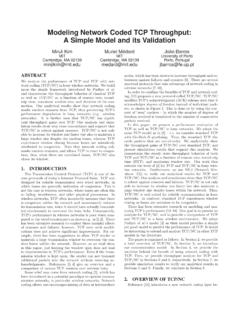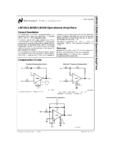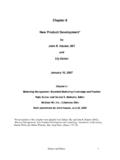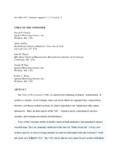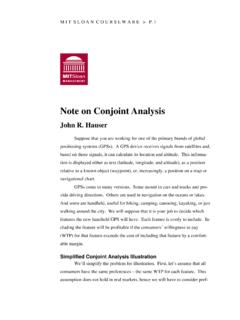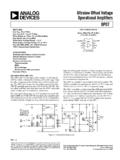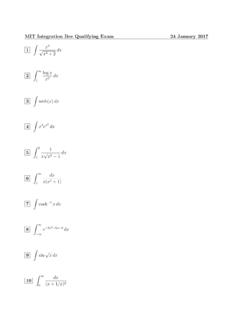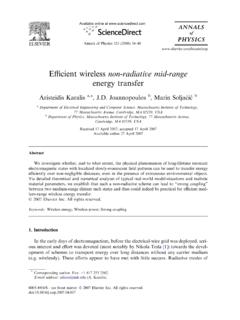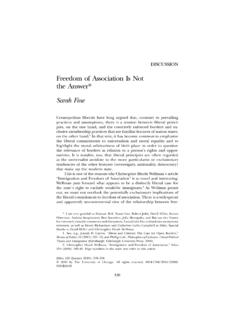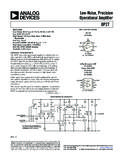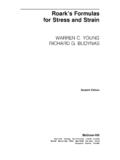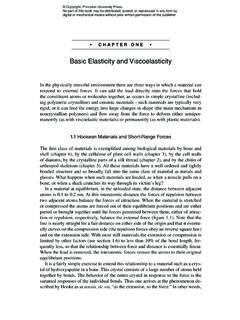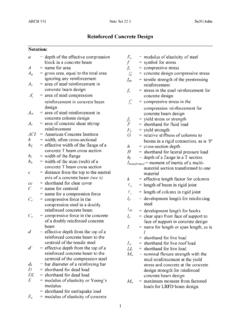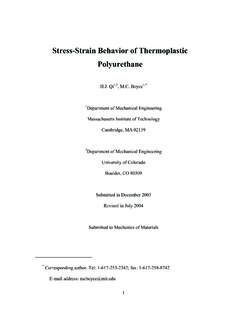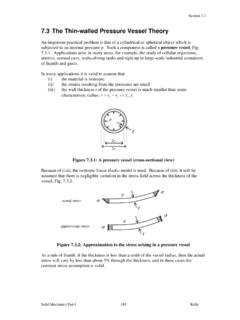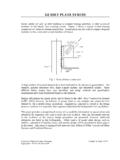Transcription of 1 Stress, strain, and displacement wave equation ... - MIT
1 32 geophysics 130:introduction to , strain , and displacement !wave equationstressstraindisplacementconstitu tive lawequation of motiongeometric : Relationship of each the relationship between stress , strain , and displacement , wecan derive a3D elastic wave equation . relationshipsbetween each pair of parameters. In this section, I will show eachterm in , characterizes vibrations, is distance of a particle fromits position of characterizes forces applied to a is a tensor, and the first subscript indicates the surface appliedand the second the direction ( ). characterizes deformations under stress . If stresses are appliedto a material that is not perfectly rigid, points within it move withrespect to each other, and deformation +dxu(x)u(x+dx)=parallel translation+rotation+ : displacement includesparallel translation, rotation, anddeformation ( strain ).
2 Let us consider an elastic material which movesu(x)( ).When the original location of the material isx, the displacement of anearby point originally atx+dxcan be written asui(x+dx) ui(x)+ ui(x) xjdxj=ui(x)|{z}parallel translation+dui|{z}rotation+de f ormation,( )basic physics for seismology 33 Therefore, in the first-order assumption,dui= ui(x) xjdxj=12 ui xj+ uj xi!dxj+12 ui xj uj xi!dxj=12(ui,j+uj,i)dxj+12(r u dx)i=(eij+wij)dxj,( )wherewijis a rotational translation term (diagonal term is zero,wij= wji). Theneij=eis the strain tensor, which contains thespatial derivatives of the displacement field. With the definition ofeij,the tensor is symmetric and has6independent the diagonal terms ofeijare zero, we do not have volumechanges. The volume increase,dilatation, is given by the sum ofthe extensions in thexidirections:eii= u1 x1+ u2 x2+ u3 x3=tr(e)=r u=q( )This dilatation gives the change in volume per unit volume associ-ated with the deformation.
3 Ui/ ximentions displacement of thexidirection changes along the direction ofxi. 1+ u1 x1 dx1 1+ u2 x2 dx2 1+ u3 x3 dx3 1+ u1 x1+ u2 x2+ u3 x3 dx1dx2dx3=(1+q)V=V+DV,( )whereq= lawRelationship between displacement and strain , which representsgeometric properties (deformation).As we have already found in ,e=12 ru+(ru)T ( ) of motionRelationship between displacement and stress , which representsdynamic properties (motion).34 geophysics 130:introduction to seismologyWe write Newton s second law in terms of body forces andstresses. When I consider the stresses in thex2direction (the redarrows in ),{s12(x+dx1 n1) s12(x)}dx2dx3+{s22(x+dx2 n2) s22(x)}dx1dx3+{s32(x+dx3 n3) s32(x)}dx1dx2+f2dV=r 2u2 t2dV( )wheredV=dx1dx2dx3. With a Taylor expansion, s12 x1+ s22 x2+ s32 x3 dV+f2dV=r 2u2 t2dV( )We also have similar equations forx1andx2directions, and by usingthe summation convention,sij,j(x,t)|{z}sur f ace f orces+fi(x,t)|{z}body f orces=r 2ui(x,t) t2r s+f=r u.
4 ( )This is the equation of motion, which is satisfied everywhere in acontinuous medium. When the right-hand side in , we have the equation of equilibrium,sij,j(x,t)= fi(x,t),( )and if no body forces are applied, we have the homogeneous equa-tion of motionsij,j(x,t)=r 2ui(x,t) t2.( ) equationsRelationship between stress and strain , which represents materialproperties (strength, stiffness). Here, we consider the material has alinear relationship between stress and strain (linear elastic). Linearelasticity is valid for the short time scale involved in the propagationof seismic on Hooke s law, the relationship between stress and strain issij=cijklekls=ce,( )where constantcijklis the elastic moduli, which describes the proper-ties of the physics for seismology 35 Not all components ofcijklare independent. Because stress andstrain tensors are symmetric and thermodynamic consideration;cijkl=cjikl=cijlk=cklij.
5 ( )Therefore, we have21independent components incijkl. With VoigtStrain energy is defined byW=12 ZsijeijdV=12 ZcijkleijekldV,Therefore,cijkl= , we change the subscripts with11!1, 22!2, 33!3, 23!4, 13!5, 12!6,and we can write the elastic moduli ascij(i,j=1, 2, ,6). Withthese21components, we can describe general anisotropic equation (general anisotropic media)geometric lawe=12 ru+(ru)T ( ) small perturbationequation of motionr s=r u( ) small perturbation continuous materialconstitutive laws=ce( ) small perturbation continuous material elastic materialWave equation describes vibrations (u) at each space (x) and time (t)under material properties (c,r);f(u,x,t,r,c)=F.( )In homogeneous case (F=0),f(u,x,t,r,c)=0.( )We eliminatesandeby plugging in , , c 12hru+(ru)Ti =r u( )This is a general wave equation for anisotropic elastic moduli in isotropic mediaOn a large scale (compared with wave length), the earth has approxi-mately the same physical properties regardless of orientation, whichis calledisotropic.
6 In the isotropic case,cijklhas only two indepen-dent components. One pair of the components are called the Lam constantsland , which are defined ascijkl=ldijdkl+ (dikdjl+dildjk).( ) is called the shear modulus, butldoes not have clear physicalexplanation. By using the Voigt recipe, be writtenwith a matrix form;cij=0 BBBBBBBB@l+2 ll000ll+2 l000lll+2 000000 000000 000000 1 CCCCCCCCA( )36 geophysics 130:introduction to seismologyIn the isotropic media, +2 eij=lqdij+2 eijs=ltr(e)I+2 e( )whereqis the are other elastic moduli, which are related to the Lam constants, such as bulk modulus (K), Poisson s ratio (n), and Young smodulus (E) ( ).(l, )(l,n)(K,l)(E, )(K, )(E,n)( ,n)(K,n)(K,E)Kl+23 l(1+n)3nE 3(3 E)E3(1 2n)2 (1+n)3(1 2n)nl2(l+ )l3K lE2 3K 2 2(3K+ )3K E6KE (3l+2 )l+ l(1+n)(1 2n)n9K(K l)3K l9K 3K+2 2 (1+n)3K(1 2n)l : Elastic equation in isotropic mediageometric lawe=12 ru+(ru)T ( ) equation of motionr s=r u( )constitutive laws=ltr(e)I+2 e( )Using of , we can derive the waveequation in an isotropic , , , the isotropic wave equation isr u=(l+2 )r(r u) r r u,( )with an assumption of slowly-varying material (rl 0andr 0).
7 R uvolumetric deformationr ushearing deformation24 geophysics 130:introduction to stressesFor any stress tensor, we can always find a direction of nthat definesthe plane of no shear stresses. This is important for earthquakesource find the direction nis an eigenvalue problem:s n=l n(s lI) n=0,( )wherelis eigenvalues, not a Lam constant. To findl, we need tosolveRelationship between the originalstress tensorsand principle @s1000s2000s31A=0@l1000l2000l31A=RTsRwhe reRis the rotational matrix basedon the eigenvectors:R=0B@n(1)1n(2)1n(3)1n(1)2n( 2)2n(3)2n(1)3n(2)3n(3)31 CAdet[s lI]=0,( )and obtain three eigenvaluesl1,l2, andl3(|l1| |l2| |l3|),which are theprincipal stresses(s1,s2, ands3, respectively). Corre-sponding eigenvectors for each eigenvalue define theprincipal stress axes( n(1), n(2), and n(3)). on a faultThe traction at an arbitrary plane of orientation (s) is obtained bymultiplying the stress tensor bys:T( n)=s n.
8 ( )Using this relationship, we can compute a traction on a the2D case, the stress tensor iss= s11s12s21s22!.( )When the fault is orientedq(clockwise) from thex1axis, the normalvector is n= sinqcosq!.( )Therefore, from , the traction on the fault isT( n)= s11s12s21s22! sinqcosq!,( )which indicates the direction and strength of the traction on thefault. We can decompose the traction into normal (TN) and shearTStractions on the fault: f=R nwhereR= cos(p/2)sin(p/2) sin(p/2)cos(p/2) = 01 10 basic physics for seismology 25TN=T( n) n= s11s12s21s22! sinqcosq! sinqcosq!TS=T( n) f= s11s12s21s22! sinqcosq! cosq sinq!,( )where fis the unit vector parallel to the fault stressesBecause in the deep Earth, compressive stresses are dominant, onlyconsidering the deviatoric stresses is useful for many example, the deviatoric stresses result from tectonic forces andcause earthquake the mean normal stress is given byM=(s11+s22+s33)/3,the deviatoric stress issD=s MI( )24 geophysics 130:introduction to wavesWith components, the3D isotropic wave equation can be written asr0BB@ 2u1 t2 2u2 t2 2u3 t21 CCA=(l+2 )0 BBB@ x1 u1 x1+ u2 x2+ u3 x3 x2 u1 x1+ u2 x2+ u3 x3 x3 u1 x1+ u2 x2+ u3 x3 1 CCCA 0 BBB@ x2 u2 x1 u1 x2 x3 u1 x3 u3 x1 x3 u3 x2 u2 x3 x1 u2 x1 u1 x2 x1 u1 x3 u3 x1 x2 u3 x2 u2 x3 1 CCCA( ) and S-wave velocitiesWe can separate solutions for P and S waves bycalculating the divergence and curl.
9 R u=(l+2 )r(r u) r r u,When we compute the divergence of , we obtainr 2(r u) t2=(l+2 )r2(r u)r2(r u) 1a2 2(r u) t2=0,( )whereais the P-wave velocity:a=sl+2 r.( )r (rf)=0r (r g)=0r r u=rr u r2uBy computing the curl of , we obtainr 2(r u) t2= r r r ur 2(r u) t2= r2(r u)r2(r u) 1b2 2(r u) t2=0,( )wherebis the S-wave velocity:b=r r.( )Usingaandb, we can rewrite u=a2r(r u)|{z}Pwave b2r (r u)|{z}Swave( ) vector field can be represented as a sum of curl-free and divergence-free forms1(so calledHelmholtz decomposition),1 Keiiti Aki and Paul G. Seismology. Univ. ScienceBooks, CA, USA,2edition,2002basic physics for seismology 25u=rf+r Yr F=0,( )wherefis P-wave scalar potential andYis S-wave vector , we haver u=r2f( )r u=r r Y= r2Y( )Inserting ,weobtain two equations for these potentials:r2f 1a2 2f t2=0( )r2Y 1b2 2Y t2=0,( )and P- and S-wave displacements are given by gradient offand exactly the same as the3D scaler wave equation we expectedfrom the1D one ( ).
10 OfYin wavesBecause of the shape of wave equations ( , , ), elastic wave equations also have plane waves as solution is a solution to the wave equation in which thedisplacement varies only in the direction of wave propagation andconstant in the directions orthogonal to the wave propagation. Thesolution can be written asu(x,t)=f(t s x/c)=f(t s x)=Ae i(wt k x)( )wheresis the slowness vector andcis the velocity. The slownessvector shows the direction of the wave thewavenumber wavesA spherical wave is also a solution for3D scalar wave equation ( ). For convenience, we consider the spherical coordinates,and (r)=1r2 r r2 f r2 1r2 r r2 f r 1a2 2f t2=0.( )Forr6=0, a solution of (r,t)=f(t r/a)r,( )which indicates spherical geophysics 130:introduction to of P and S wavesLet us consider P plane waves propagating inx1direction. A plane-wave solution for (x1,t)=Aei(wt kx1),( )and the displacement isu(x1,t)=rf(x1,t)=( ik, 0, 0)Aei(wt kx1).
